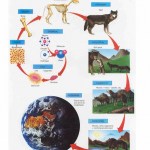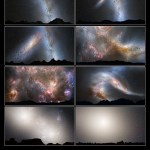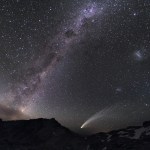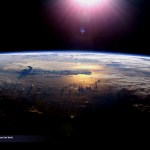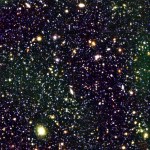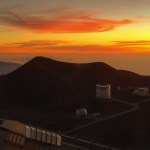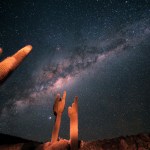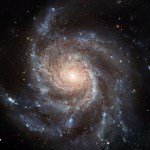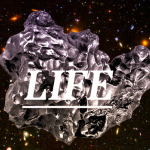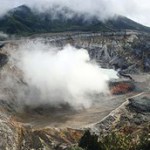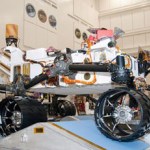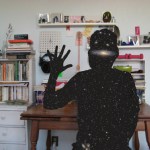universe
"History is full of people who out of fear, or ignorance, or lust for power has destroyed knowledge of immeasurable value which truly belongs to us all. We must not let it happen again." -Carl Sagan
From the streets and people of our hometown to the nations, planets, stars and galaxies (and beyond) of our Universe, there's an immensity of knowledge to be gained from a single human lifetime, if only we have the courage to let go of our preconceptions and discover it. Laura Viers might tell you that in her own way in her 2005 song,
Galaxies.
But no one is born with this knowledge; it takes hard…
"It is by going down into the abyss that we recover the treasures of life. Where you stumble, there lies your treasure." -Joseph Campbell
One of the bravest things that was ever done with the Hubble Space Telescope was to find a patch of sky with absolutely nothing in it -- no bright stars, no nebulae, and no known galaxies -- and observe it. Not just for a few minutes, or an hour, or even for a day. But orbit-after-orbit, for a huge amount of time, staring off into the nothingness of empty space, recording image after image of pure darkness.
What would we find, out beyond the limits of what…
"I am always ready to learn, although I do not always like to be taught." -Winston Churchill
My very first time leading a classroom -- on my own -- was back in June of 2000. I was 21 years old, fresh out of college, and was teaching science in a middle school classroom. And I asked what I thought was an innocuous question, designed to pique their curiosity. I asked the class, "What are we -- you, me, and all human beings -- made of?"
I was expecting many possible answers common to all living things, ranging from "blood and guts" to cells, molecules, or atoms. From a scientific…
"Not even light can escape such hollowing, this huge mass in a small space. Even the Milky Way with its open arms is said to have a black hole at its heart." -Susan B.A. Somers-Willett
Our Milky Way is home to us all. With its hundreds of billions of stars, massive spiral arms, dust lanes, and orbiting globular clusters, it's no wonder that nearly everything we see in the night sky is contained within it.
Image credit: All rights reserved by Flickr user Greg Booher.
I say nearly everything, of course, because there are a few exceptions. The Andromeda Galaxy, for one, as well as…
"It is always wise to look ahead, but difficult to look further than you can see." -Winston Churchill
We've come a long way in this Universe. Over the past 13.7 billion years, we've formed the light elements out of a sea of protons and neutrons, cooled and expanded to form neutral atoms for the first time, gravitationally collapsed hydrogen and helium gas clouds to form the first stars, borne witness to generations of stellar deaths and rebirths, lived through the formation of hundreds of billions of galaxies and the clustering together of thousands or more galaxies into clusters, filaments,…
"Who are we? We find that we live on an insignificant planet of a humdrum star lost in a galaxy tucked away in some forgotten corner of a universe in which there are far more galaxies than people." -Carl Sagan
Our night sky, quite literally, is our window to the Universe.
Image credit: Miloslav Druckmuller, Brno University of Technology.
Well, it's kind of a window to the Universe. I say only "kind of" because, with the exception of those two faint, fuzzy clouds in the lower right, everything else visible in the image above is part of our own Milky Way galaxy. In fact, practically…
"How old would you be if you didn't know how old you are?" -Satchel Paige
Today marks another year and another trip around the Sun for me. For you, and me, and everything on Earth that makes it through another year on this world, there's a whole lot we get to experience.
Image credit: NASA / ISS Expedition 13.
Some things are tiny: the Earth's rotation slows by about two millionths of a second each year, while some are large: we hurtle over 900 million kilometers in outer space as we orbit around the Sun. Our Earth spins just over 366 times on its axis, while our one revolution around…
"Nothing exists except atoms and empty space; everything else is just opinion." -Democritus of Abdera
When you take a look out at the Universe, past the objects in our own solar system, beyond the stars, dust and nebulae within our own galaxy, and out into the void of intergalactic space, what is it that you see?
Image credit: BRI composite-image of the FORS Deep Field, ESO, VLT.
What we normally think of as the entire Universe, consisting of hundreds of billions of galaxies, with about 8,700 identified in the tiny patch of deep-sky shown above. Each one of those galaxies, itself…
"The greatest enemy of knowledge is not ignorance, it is the illusion of knowledge." -Stephen Hawking
The Universe is a vast, seemingly unending marvel of existence. Over the past century, we've learned that the Universe stretches out beyond the billions of stars in our Milky Way, out across billions of light years, containing close to a trillion galaxies all told.
Image credit: NASA, ESA, S. Beckwith (STScI) and the HUDF Team.
And yet, that's just the observable Universe! There are good reasons to believe that the Universe continues on and on beyond the limits of what we can see; the…
"You don't use science to show that you're right, you use science to become right." -Randall of xkcd
In January of 2008, I began writing this blog, Starts With A Bang, both for myself and for all of you, because we all have something in common.
Image credit: © Stéphane Guisard, "Los Cielos de Chile", via astrosurf.com.
The same planet, the same heavens, the same laws of nature and the same Universe are something that we all have in common. And all of us, no matter how intrinsically smart, talented, or brilliant our instincts are, come into this world knowing absolutely…
"This seems to be the law of progress in everything we do; it moves along a spiral rather than a perpendicular; we seem to be actually going out of the way, and yet it turns out that we were really moving upward all the time." -Frances Willard
As spring gives way to summer here in the Northern Hemisphere, one of the most beloved sights of the night sky becomes ever more prominent: the Big Dipper.
(Image credit: NASA, ESA, Z. Levay (STScI) and A. Fujii.)
These seven bright stars shine high above the horizon after sunset, and will continue to do so over the rest of the Spring and all Summer…
By Dr. Gerry Harp, Senior Astrophysicist, Center for SETI Research, SETI Institute, and Gail Jacobs
Trained as a quantum mechanic, Dr. Gerry Harp was deeply interested in possibilities for using the multiple telescopes of the Allen Telescope Array to generate steerable "beams" on the sky -- beams that could be far smaller than any single antenna could produce. Such beams don't emit anything, but work in reverse by capturing only energy that comes from the sky in a certain direction. Gerry joined the SETI Institute in 2000, practically at the telescope's inception and uses the telescope for…
The Book of Exogenesis: In the beginning was the word, and the word was a meteorite...
Earlier this month, a report, based on NASA studies of meteorites found on Earth, suggested that some building blocks of DNA may have been formed in space.
As it turns out, DNA components have been found on meteorites before, but it's never been entirely clear if the space rocks came to Earth bearing these molecules, or if they were contaminated upon arrival. Furthermore, this recent study of meteorites was the first to discover trace amounts of three molecules -- purine, 2,6-diaminopurine, and 6,8-…
Remembering Dr. Emma Bakes
An exceptional person, Dr. Emma Bakes passed away on February 28, 2011. She accomplished a great deal and touched many people in an unfortunately short time. Her accomplishments span oceans and included the physical sciences, medicine, fashion, martial arts, and parenthood to name just a few. To honor and remember her, the SETI Institute and NASA's Kepler Mission Team invite you to read the following essay she wrote just a few months ago. It is an essay that reflects her life and her legacy...
Donald Mendoza, NASA Ames, and the SETI Institute
The Shore of the Cosmic…
By Dr. Ignacio Mosqueira, an astrophysicist at the Carl Sagan Center for the Study of Life in the Universe, SETI Institute, and Gail Jacobs
Ignacio Mosqueira works with Paul Estrada to piece together the way in which giant planets - such as Jupiter and Saturn -- and their moons and rings formed. Ignacio notes that making moons is similar to forming planets. Understanding moons may have something to tell us about the possible habitats for life, since large moons could, in principle, have both the liquid water and atmosphere necessary for the kind of diverse biology we see on planet Earth.…
By Dr. Rosalba Bonaccorsi
Environmental Scientist at the Carl Sagan Center for the Study of Life in the Universe, SETI Institute, and Gail Jacobs
Rosalba, what first sparked your interest in science?
I've always had big dreams -- even as a young girl. As soon as I started to walk, I took an interest in conducting experiments with whatever was available around such as household plants and various chemical compounds. I'm lucky I didn't end up poisoned or otherwise hurt! I remember dismantling alarm clocks. I was so curious!
As a young girl, I was in poor health and as a result spent a lot of…
By Dr. Mark R. Showalter
Planetary astronomer at the Carl Sagan Center for the Study of Life in the Universe, SETI Institute
It was just a few months ago that Stephen Hawking was making headlines with his bold assertion that extraterrestrial beings, if they exist, are best avoided. His argument was based in part upon the fact that the arrival of Christopher Columbus to the "New World" didn't work out so well for the Native Americans who were already here. However, upon closer inspection, Hawking's ideas fell apart. Even if nomadic tribes of ETs are really out there looking for a handy source…
tags: Alex Filippenko, Josh Frieman, FermiLab, astronomy, astrophysics, Science Bulletins, research, American Museum of Natural History, AMNH, New York City, space, nature, universe, The Expanding Universe, streaming video
In 1998, astrophysicists discovered a baffling phenomenon: the Universe is expanding at an ever-faster rate. Either an enigmatic force called dark energy is to blame or a reworking of gravitational theory is in order. In this new Science Bulletins video, watch a FermiLab team assemble the Dark Energy Camera, a device that could finally solve this space-stretching mystery…
How do we begin?
Well, hello. My name is Claire L. Evans, and I'm new here.
I began writing this blog, Universe in 2005, over at the Portland, Oregon-based web community Urban Honking. At first, it was a vanity project, a noodle, an excuse to keep my grey matter engaged beyond my college years (which were, to say the least, unscientific). In the years since, Universe has taken on various incarnations: briefly as a print column in the now-defunct LA Alternative, which earned me the closest I've ever come to "accolades" (these breezed quickly past), then as a micro-blog for GOOD Magazine.…
tags: nature, cosmos, streaming video
This amazing video takes us on a fantastic journey from the outer universe down to the earth, then into a leaf and on into submolecular structures, for a look at quarks that make up atoms.

